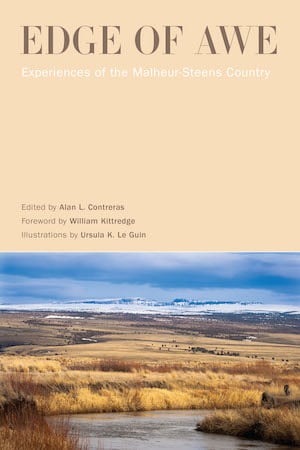
Funny how a word can change on you.
When I moved to Oregon nearly a decade ago, I first heard about the Malheur National Wildlife Refuge, about the Steens mountain range, and the diversity of bird species that migrate through this region.
Back then, Malheur meant wilderness.
But in 2016, after group of armed men held the Malheur National Wildlife Refuge hostage, Malheur took on a very different, much darker meaning.
But after reading Edge of Awe, I am reminded that 2016 was just a blip in time in a region of the world that has been home to humans and animals for many thousands of years.
Edge of Awe, edited by Alan Contreras and featuring illustrations by Ursula K. Le Guin, is an anthology of prose by writers recounting their experiences with the Malheur-Steens Country.
Peter Walker takes us back more than 14,000 years, when the Paiute, the first human inhabitants, lived in the region. The Paiute were largely nomadic, following food sources and seasons. When the Europeans arrived in the nineteenth century, they viewed this way of life as not only foreign, but less civilized. And it’s no surprise that the fate of the Paiute followed a familiar template across so much of North America. The eradication of the natives left the region wide open for the hunters and other extractors, such as those in search of colorfully feathered birds to fuel the insatiable demand for feathers to adorn women’s hats. William Finley, witnessed the near-extermination of white egrets and used photographs to lobby President Teddy Roosevelt to protect this area; in 1908, Roosevelt created the Malheur National Wildlife Refuge.
Malheur National Wildlife Refuge is a major migration byway for birds. A short essay by Tom McAllister notes that on one day in 1942 he saw 76 bird species. Even today the diversity of wildlife one can see in these parts is amazing. Malheur today draws birders in flocks to witness the birds it draws in the millions.
Harry Fuller provides a wonderful essay on the common nighthawk, which, as he notes, isn’t a hawk nor is it nocturnal. But boy would I love to see one in flight.
Ellen Waterston writes about the the occupation, the tensions that did not leave with the news vehicles, a tension that preceded so many other tensions.
But what strikes me about Malheur is that birders (and other wildlife watchers) are the only people drawn to this region who are not extracting something from it. The ranchers, the miners, the sheep herders, this is their office, their source of income. An income born on the backs of so many species of animals. Grazing rights. Federals lands. Regulations and redoubters. This occupation could have taken place at any number of refuges or wilderness areas. But they chose Malheur.
Birders are now a major revenue sources for this region, so it’s important we keep visiting, to remind the world that refuges such as this one, are for animals. And we are merely bystanders.
Edge of Awe provides a literary foundation for a region of the world that has seen great violence and tragedy but also stands as a beacon of hope for anyone who believes that humans can (and should) coexist with wildlife.
I’ll leave you with an excerpt from a poem by Oregon poet William Stafford titled “Malheur Before Dawn” in which he writes about birds and other creatures:
Frogs discovered their national anthem again
I didn’t know a ditch could hold so much joy.
Edge of Awe
Oregon State University Press
John is co-author, with Midge Raymond, of the Tasmanian mystery Devils Island. He is also author of the novels The Tourist Trail and Where Oceans Hide Their Dead. Co-founder of Ashland Creek Press and editor of Writing for Animals (also now a writing program).

